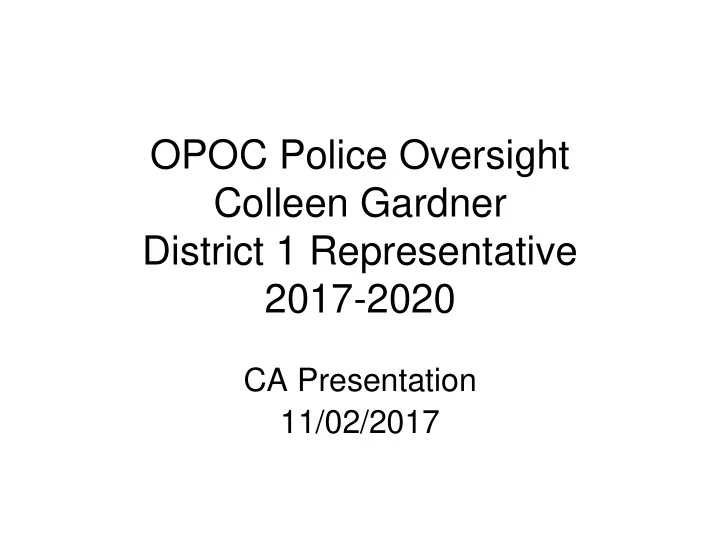

OPOC Police Oversight Colleen Gardner District 1 Representative 2017-2020 CA Presentation 11/02/2017
History • The first efforts to establish civilian oversight began in 1928. • There are more than 200 civilian oversight entities across the United States — no two are exactly alike. • Most large cities and large law enforcement agencies have oversight agencies, as do a growing number of small and mid-size cities. • Many began in reaction to specific incidents of police • Civilian oversight has been prominently featured in US-DOJ settlement agreements. • NACOLE stated in 1995 • 11-member, all-volunteer Board of Directors elected by • the membership • Conducts annual training and community-building conferences and numerous regional meetings
Civilian oversight • Civilian Oversight of Law Enforcement: • Investigates, audits, or reviews internal law, enforcement investigations or processes, including citizen complaints and use of force incidents. • Conducts ongoing monitoring of law enforcement agencies’ policies, procedures, training, and management and supervision practices. • Includes any agency or procedure that involves active participation in the above by persons who are not sworn officers.
Benefits of Oversight • BENEFITS FOR COMMUNITIES Builds bridges between law enforcement and the public • Promotes two-way listening and mediation • Provides constructive feedback to police and government • Supports effective and constructional policing • Protects civil rights • Ensures greater accountability • Enhances risk management • Increases public confidence and trust in the police when they understand why policies, procedures and laws exist
Benefits of Oversight INTERNAL BENEFITS FOR LAW ENFORCEMENT • Enhances a risk-management system or strategy • Supports changes in officer behavior • Enhances credibility of law enforcement agency and its disciplinary process with officers • Improves quality and integrity of investigations • Improves agency performance • Increases transparency
Additional benefits to Law Enforcement • Enhances credibility of law enforcement agency and its disciplinary process with the public • Encourages citizens to be pro-active in reporting crimes in their community to law enforcement that they can trust • Improves perceived quality and integrity of investigations • Provides a forum for the public to raise concerns • Creates a structured mechanism for the public to provide input into policing
Shared Responsibility • Shared Responsibility between the Oversight Agency and Law Enforcement to Promote Transparency is Important in: • Enacting policies to improve citizen confidence such as access to police reports, video, radio transmissions • Providing access to reports of findings resulting from citizen complaints • Reassuring the community at large that discipline and retraining is being imposed when appropriate, while also increasing the transparency of the disciplinary and training processes
Shred responsibility continues • Shared Responsibility between the Oversight Agency and Law Enforcement to Promote Transparency is Important in: • Tracking complaints against officers to identify patterns • and trends • Promoting mechanisms that value human rights in all encounters with the police • Improve community relations by fostering communication between the community and police agency • Collecting data on numbers and types of complaints filed
Continued • Oversight Demonstrates the Accountability of the Law Enforcement to Government Officials and Therefore to the Public by: • Supporting the goals of community oriented policing • Helping law enforcement hold individual officers accountable for actions and meeting departmental standards. • Improving the quality of the department’s internal investigations of alleged misconduct
Expectations of Oversight • What You Can Reasonably Expect from a Civilian • Oversight Agency: • Familiarity with police practices, investigations, and criminal law/criminal procedure • Impartial and objective • Willingness to meet and communicate with police organization and staff • Compliance with confidentiality laws and evidentiary standards • Willingness to consider all sides of a situation and ability to re-evaluate if additional/contrary information/evidence received
Proactive versus reactive • Civilian Oversight Is Now Commonly: • Being PROACTIVE • Exploring problems proactively (e.g., investigation, collection, and analysis of data) • Identifying underlying issues and causes • Focusing on organizational change • Concentrating on reduction and prevention of misconduct • Building partnerships with law enforcement • Creating bridges between law enforcement and the wider community
What Works • Q: IS ONE MODEL BETTER THAN ANOTHER? • No: each model has strengths and weaknesses. • When deciding what model to implement, the needs of • the community should be carefully assessed: • History and “narrative” of the community or communities • Level of support; both financial and political • Level of authority and independence • Expected outcomes • Reduced focus at the federal level • Increased reliance on city and state intervention
Recommend
More recommend